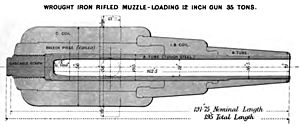RML 12-inch 35-ton gun facts for kids
Quick facts for kids Ordnance RML 12-inch 35-ton gun |
|
|---|---|

An interior view of one of the two main battery turrets aboard the British battleship HMS Devastation, showing a rear view of the turret's two 12-inch (305 mm) 35-ton rifled muzzle-loaders. These guns were replaced in 1891 by 10-inch (254 mm) breech-loading rifles.
|
|
| Type | Naval gun |
| Service history | |
| In service | 1873–1909 |
| Used by | Royal Navy |
| Production history | |
| Designed | 1871 |
| Manufacturer | Royal Arsenal |
| Unit cost | £2,154 |
| No. built | 15 |
| Specifications | |
| Mass | 35 long tons (36,000 kg) |
| Barrel length | 162.5 inches (4.13 m) (bore + chamber) |
|
|
|
| Shell | 706 pounds 12 ounces (320.6 kg) (Palliser) 613 pounds (278.1 kg) (Common & Shrapnel) |
| Calibre | 12-inch (304.8 mm) |
| Muzzle velocity | 1,390 feet per second (420 m/s) |
RML 12-inch 35-ton guns were large rifled muzzle-loading guns used as primary armament on British battleships of the 1870s. They were the longer and more powerful of the two 12-inch British RML guns, the other being the 25-ton gun.
Contents
Design
This gun design originated in 1871 as an 11.6-inch (295 mm) gun firing a 700-pound (317.5 kg) projectile. Results were unsatisfactory, leading to the gun being bored out to 12 inches (305 mm) and firing a 706-pound-12-ounce (320.6 kg) shell.
Guns were mounted on:
- Devastation-class battleships of 1873
Note: The two 12-inch guns installed in HMS Thunderer's forward turret were 12.5-inch 38-ton guns bored instead to 12 inches, and designated "12-inch 38-ton", as the necessary 12-inch 35-ton guns were not available. These 2 guns used the same charges and projectiles as the standard 12-inch 35-ton guns installed in Thunderer's aft turret which simplified the supply of ammunition. It was one of these "12-inch 38-ton" guns that was accidentally double-loaded and exploded on 2 January 1879.
Ammunition
When the gun was first introduced projectiles had several rows of "studs" which engaged with the gun's rifling to impart spin. Sometime after 1878, "attached gas-checks" were fitted to the bases of the studded shells, reducing wear on the guns and improving their range and accuracy. Subsequently, "automatic gas-checks" were developed which could rotate shells, allowing the deployment of a new range of studless ammunition. Thus, any particular gun potentially operated with a mix of studded and studless ammunition.
The gun's primary projectile was 706-pound "Palliser" armour-piercing shot, which were fired with a "battering charge" of 110 pounds of "P" (gunpowder) for maximum velocity and hence penetrating power. Shrapnel and common (exploding) shells weighed 613 pounds and were fired with a "full charge" of 85 pounds "P" or 67 pounds "R.L.G.".
See also
- List of naval guns




